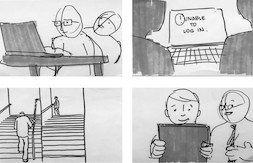 Back in April I started to play with the idea of intermediate knowledge work products. I want to push that a bit farther and argue that we ought to bring back and expand on the idea of working papers.
Back in April I started to play with the idea of intermediate knowledge work products. I want to push that a bit farther and argue that we ought to bring back and expand on the idea of working papers.
The Limits of Deliverables
Deliverables are a powerful idea for managing knowledge work. What artifacts—report, specification. contract, presentation, analysis, application—mark the end point of a chain of work? What can you create to demonstrate to your client or manager that you’ve completed the work you promised to do?
The problem with deliverables is that they discourage the process of discovery and innovation. You deliver when you are done and the only response to receiving a deliverable is to accept it—either graciously or reluctantly, but accept it either way. This problem is aggravated by our ability to turn out work products that look like finished deliverables regardless of their actual state.
Reclaiming Working Papers
“Working papers” is a concept I first encountered in my early years as a consultant working within an audit firm. An audit is a odd process; your job is to check someone else’s work and render an opinion about whether they followed the rules. The deliverable that justifies the auditor’s bill is an opinion letter stating your conclusion. What you most desire as a client is a very short letter that boils down to “yes, you followed the rules.”
Working papers are all the analyses and evidence prepared to support that final deliverable. In a paper-centric world, this creates a problem of organizing and cataloging all of the intermediate pieces of paper so that you can trace and recreate the analysis later if circumstances warrant.
On the other hand, there was also an advantage in having everything on paper. Add a date and your signature in the top corner of a memo or analysis, stick it in the files, add a new line to the index page, and your working papers were up to date. The old joke was that the files weren’t complete until there was a least one paper placemat covered with lunch notes in them.
It’s the notion of “working” that is important here; the medium is not. Thinking and managing in terms of working papers highlights the importance of process and dialog. Working papers only exist in the context of how they support the process of interaction, whether it is the interaction between data and analyst or the interaction between stakeholders seeking to understand a problem.
Digital Limits of Working Papers
The shift to digital work makes just about every aspect of knowledge work better. Preparing a spreadsheet by hand on actual 28-column paper is not an experience I wish to revisit. But we also produce digital work products in ways that obscure and interfere with the evolutionary nature of effective thinking and analysis.
One limitation of digital work products is that you must deal with version elaboration and control intentionally. All interesting work products go through an evolutionary process. Preliminary hypotheses need elaboration. The structure of an outline morphs with feedback from potential readers. Drafts beget revised drafts. Analog products reveal this evolution in the proliferation of copies and marked up drafts.
Our digital tools obscure this evolution. The spreadsheet or report file contains only the most current version. Previous versions that were naturally preserved in an analog world disappear; it takes a conscious effort to preserve an intermediate digital version. Think of the crude control efforts revealed in file names with random dates, initials, and version numbers littering the drives of the average knowledge worker.
Software developers have built sophisticated tools to support their work of evolving a code base from idea to working application. I am hard pressed to identify other knowledge workers taking advantage of those tools or practices as they develop equally complex final deliverables.
The reason that version control matters is that final deliverables grow out of interaction and dialog. That dialog is rarely linear. Future iterations grow out of the process of building analyses and testing alternative hypotheses.
This iterative development process is an essential element of doing meaningful analysis and getting all of the participants to agree with the results. Treating analysis as a process is the first step. Deliverable centric thinking obscures this. A working paper approach puts process where it belongs.
One additional step with knowledge work artifacts adds significant value at minimal cost. Our digital tools produce outputs that resemble finished product regardless of their actual state. It can be difficult to distinguish a back of the envelope calculation from an SEC-ready filing when both are printed in 11-point Arial. Adding a “DRAFT – FOR DISCUSSION PURPOSES ONLY” watermark is a small step in the right direction. What I’ve had more success with is to use fonts in working papers that drive home their intermediate status. This is a time when a font such as Charette or Papyrus sends a useful reinforcing message about the state of a knowledge work artifact.
Using Tools to Reinforce Your Intentions
We’ve been creative and adept at creating multiple digital tools to make knowledge work easier and more effective. We’ve been less thoughtful about how to deploy and use those tools to support all the relevant dimensions of our knowledge work processes. If we want to be more effective at knowledge work, then we need to be more intentional about how we fit our tools and processes to the tasks we undertake.